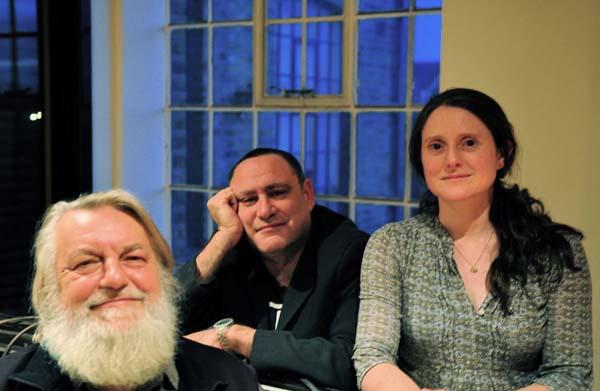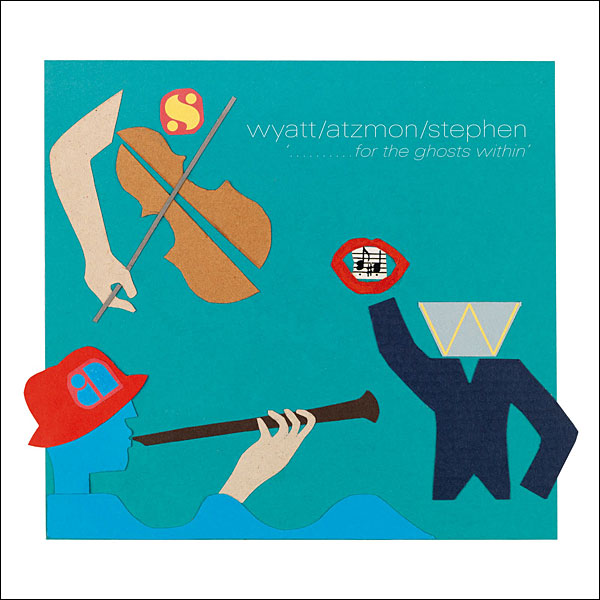| Columns Retired Columns & Blogs |
Good for you for recommending this album Stephen, I love this CD. I don't want to hear any comments about Gilad Atzmon's political views, the man is a very talented musician and that's what counts.

For the Ghosts Within marks my introduction to the wonderful world of Robert Wyatt. It happened in Denver, Colorado, at around 1am, several hours after the first full day of the 2010 Rocky Mountain Audio Fest. I'd taken a break from posting blog entries to flip through the November 2010 issue of my other favorite magazine, The Wire. There, on p.11, I saw a neat, simple ad that offered little more than an album's intriguing cover art: stencil-like cutouts of three figures that seem meant to represent the album's three musicians, though these figures are almost entirely stripped of human form, reduced or distilled to their musical functions—as if the players are their instruments. Drawn by the rich colors and provocative imagery, I went straight to Domino Recording Co.'s website and listened to "Laura," track 1 of For the Ghosts Within. (Like so much of the album, "Laura" was completely new to me, but I have since learned that it is the title song from the 1944 film Laura, composed by David Raksin, and given fine treatments by Ella Fitzgerald, Frank Sinatra, and Julie London, among others.)
That song opens with such drama. We're thrust into some old black-and-white film and met by a chorus of strings, rising and falling, wavering between tension and relief, vacillating between despair and hope. This is the Sigamos String Quartet—Ros Stephen and Tom Piggot-Smith on violins, Rachel Robson on viola, and Daisy Vatalaro on cello, with Richard Pryce accompanying on double bass. We are treated to 34 seconds of this emotional intensity before Robert Wyatt greets us with his special voice: "Laura," he trembles, "is the face in the misty night . . ."

He sings in a near-falsetto, with a near-lisp, each syllable sounded from the heart, as if the man has nothing but heart. What is this? I wondered. How have I gone 33 years without this voice? It was with that voice, at that moment, that my life became a little different, a little fuller, a little richer. Cracking and shaking and often nearly breaking, Wyatt's voice at first sounds simply wrong. But how can something so captivating be wrong? We are compelled to follow as the voice takes its many turns, as it stretches and rises and falls. A few seconds past the two-minute mark, as Wyatt's voice descends into darkness, Gilad Atzmon leads us away with his sweet alto sax. After a delicious solo—one of many memorable passages lit by Atzmon's playing—the strings create a lovely bridge and set the stage for Wyatt's return: "That was Laura, but she's only a dream." By the end of the song, we realize that Wyatt has not forsaken technical singing ability at all, but has plumbed new depths of the craft.
We are blessed. This is the perfect time to discover, or rediscover, the music of Robert Wyatt. Along with For the Ghosts Within, Domino celebrates Wyatt's rich discography with reissues of nine previous releases, from Rock Bottom (1974) to Cuckooland (2003). (Music editor Robert Baird praises these reissues elsewhere in this issue.) But forgive me for focusing on the voice—For the Ghosts Within is a collaboration. Wyatt shares songwriting credits for two of the album's four originals—Stephen, Atzmon, and Alfreda Benge, Wyatt's longtime partner, split the others—while the remaining seven tracks are loving renditions of carefully selected classics. Thelonious Monk's "Round Midnight" sets a wistful tone and has Wyatt's fine whistling accompanied by Stephen's strings and Atzmon's accordion; Duke Ellington's "In a Sentimental Mood" is a showcase for Atzmon's enchanting and marvelously expressive clarinet; Chic's "At Last I Am Free" is reborn as a soundscape of textured vocals, while preserving the original's spiritual ecstasy.
Indeed, the album plays out like a song cycle, the individual songs bound by an overarching zeal that flirts with sentimentality but never fails to stir the heart. With Wyatt, Atzmon, and Stephen, joy is always just a step away from darkness, sorrow but a turn away from bliss; they are masters at blurring the lines between these pairs of worlds. The album's darkest moments are in its title track, in which Atzmon spins ribbons of sound on a Palestinian shepherd's flute while his wife, Tali Atzmon, offers a haunting vocal. The band takes a playful step with "Where Are They Now?," a reprise of Wyatt's "Dondestan," from his 1998 album, Dondestan (Revisited)—but this version includes hip-hop vocals from Palestinian artists Shadia Mansour and Abboud Hashem, while Wyatt echoes, "Palestine's a country, or at least used to be." For the Ghosts Within closes, perfectly, with an intoxicating rendition of the Thiele-Weiss standard, "What a Wonderful World." Wyatt's memorable performance stands happily alongside that of the great Louis Armstrong.
All of the string arrangements on For the Ghosts Within are by Ros Stephen, except for those of two tracks, "What's New?" and "What a Wonderful World," which were handled by Jonathan Taylor. The Sigamos String Quartet was recorded by Philip Bagenal at London's Eastcote Studio, while Wyatt was recorded by Jamie Johnson at Gallery Studio, also in London. The sound throughout is as luscious as the music. In my system, the vinyl offered greater soundstage depth and depicted images with greater flesh, but the CD placed those images more precisely on a wider soundstage. I need both versions, of course. Sonic minutiae aside, For the Ghosts Within affects me like no other album: I can't listen to it without falling deeper in love with life. What a wonderful world, indeed.—Stephen Mejias

Good for you for recommending this album Stephen, I love this CD. I don't want to hear any comments about Gilad Atzmon's political views, the man is a very talented musician and that's what counts.